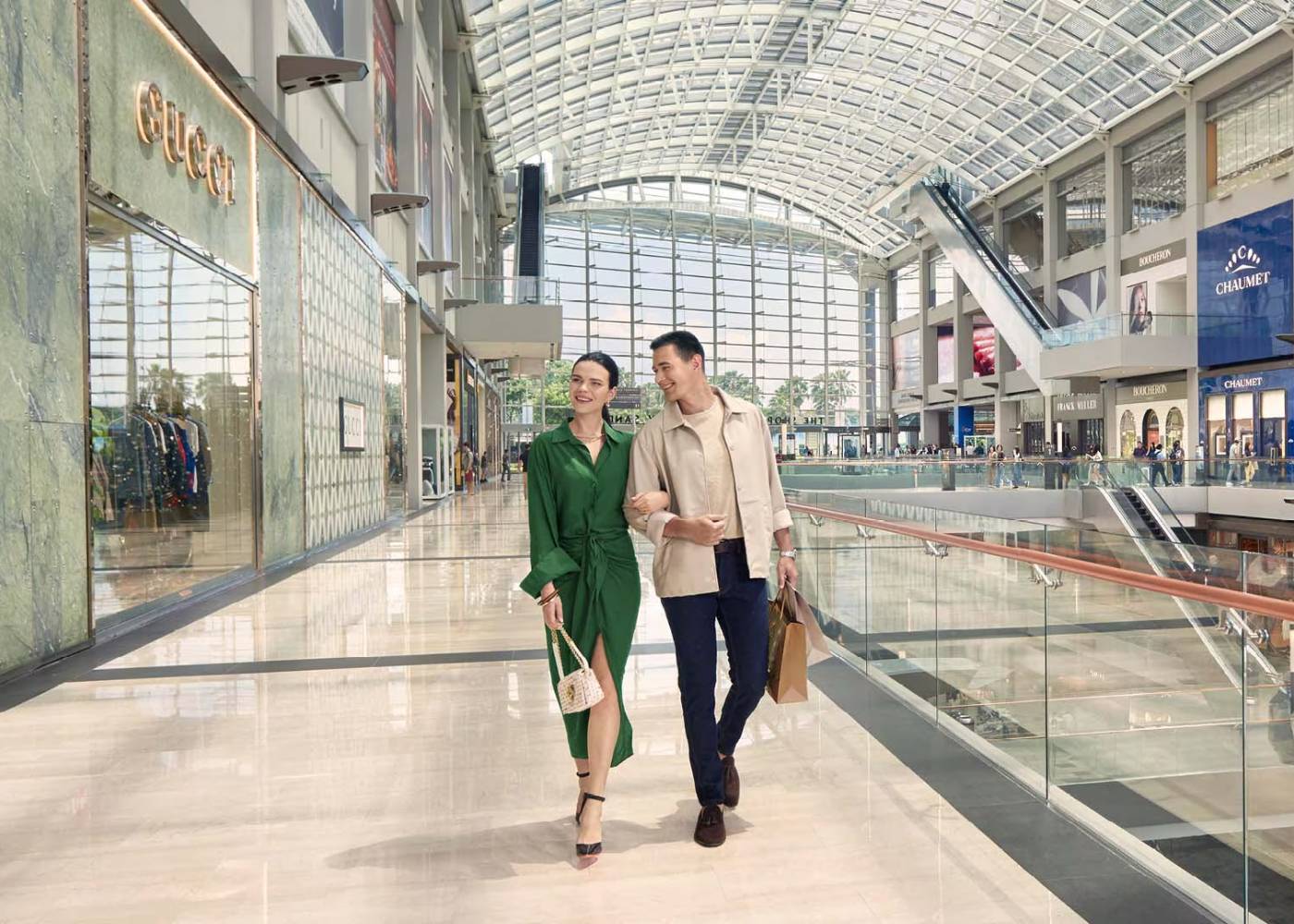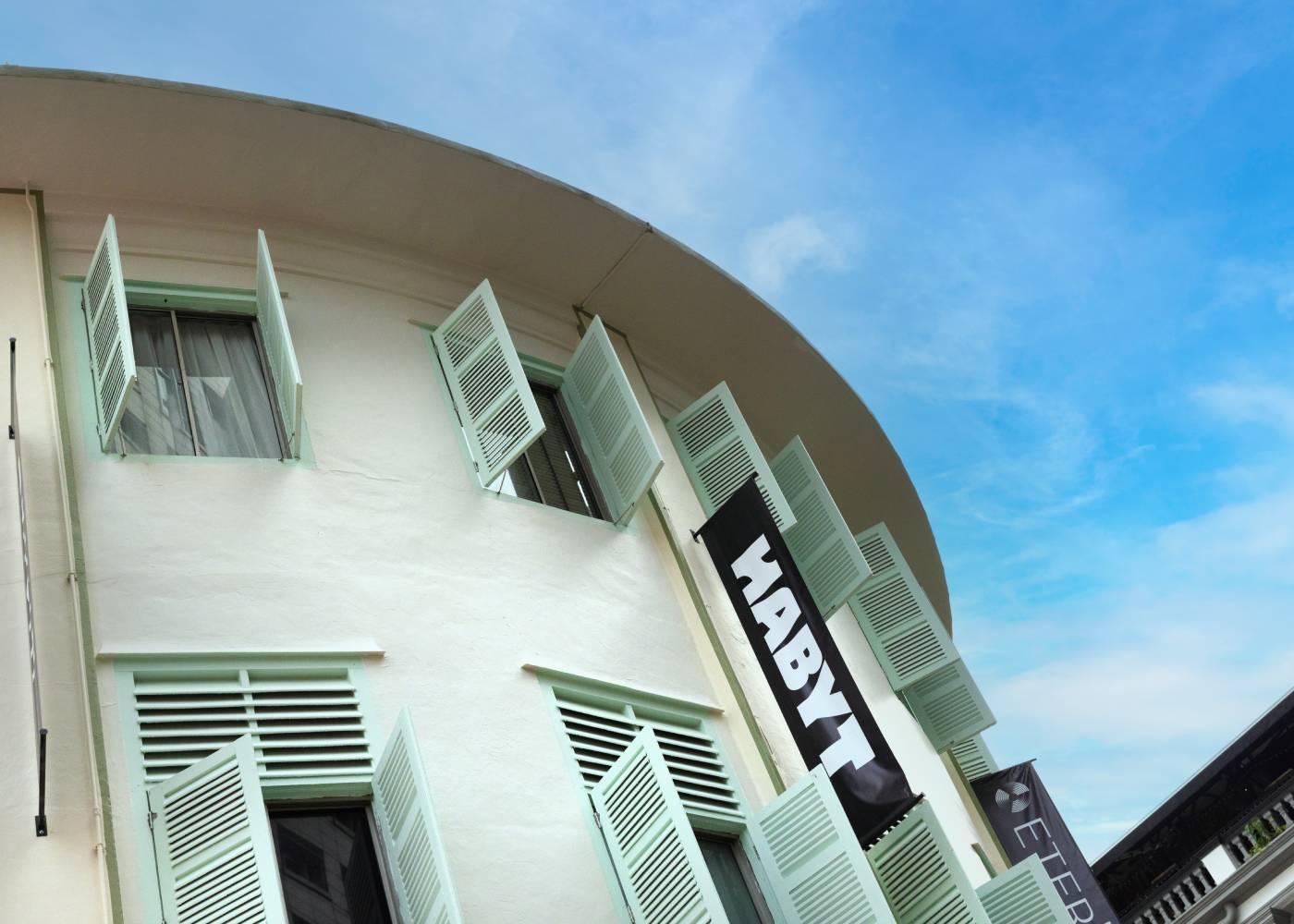Sustainability in Focus: The Design and Impact of the Singapore Pavilion at COP28
Published on January 31, 2025 | by DSGN arcHive
How can design lead the way to a sustainable future? We dive into the design of the Singapore Pavilion at COP28 in Dubai to see how.
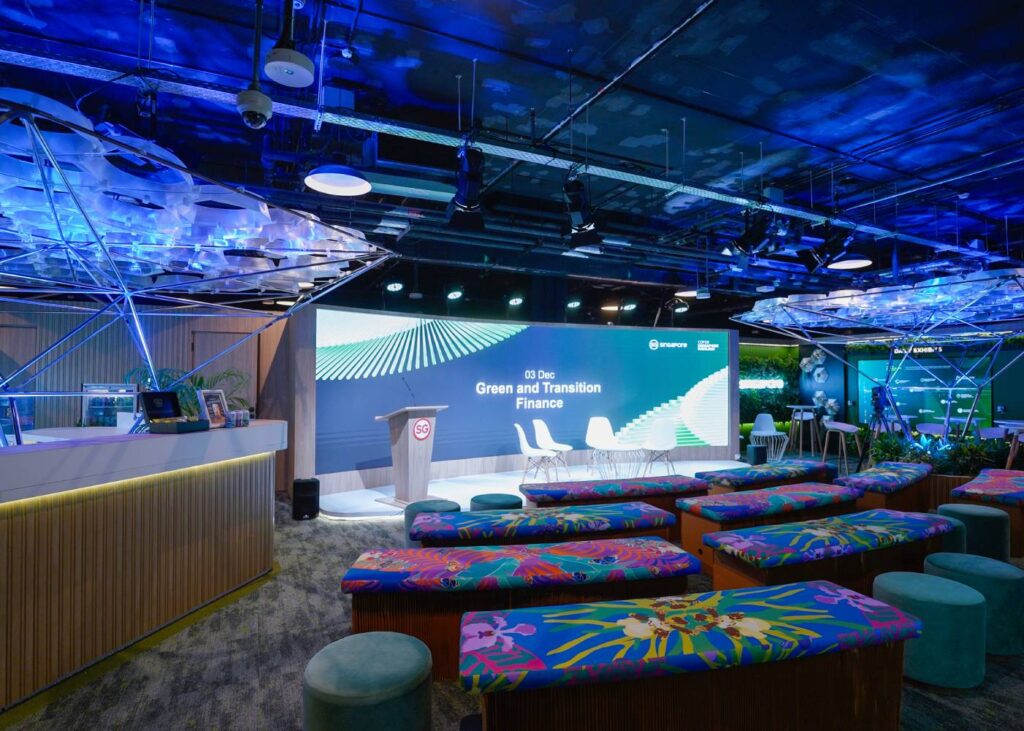
Sustainability isn’t just about reducing waste—it’s about pushing boundaries. At the Singapore Pavilion at the United Nations 28th Conference of the Parties (COP28) in Dubai, that vision came to life. Designed to showcase Singapore’s commitment to innovation and circular design, the Pavilion turned waste into something extraordinary through upcycling and 3D printing. Commissioned by the Singapore Government and brought to life by Pico Art International, it was far more than just a display. With over 6,000 visitors exploring it in person and nearly 60,000 joining from over 200 countries, it became a focal point for global collaboration on climate action. More than 70 programmes highlighted the Pavilion’s role in shifting conversations on sustainability.
Its impact didn’t stop there. The Pavilion also earned recognition at the 2024 SG Good Design Awards, proving that sustainable design can be both meaningful and groundbreaking. We caught up with Claudia Zhou, Associate Creative Director at Pico Art International, to get the inside scoop on this game-changing project.
Singapore Pavilion at the United Nations 28th Conference of the Parties
1. What inspired the design of the COP28 pavilion and the ‘Waste to Wonder’ theme?
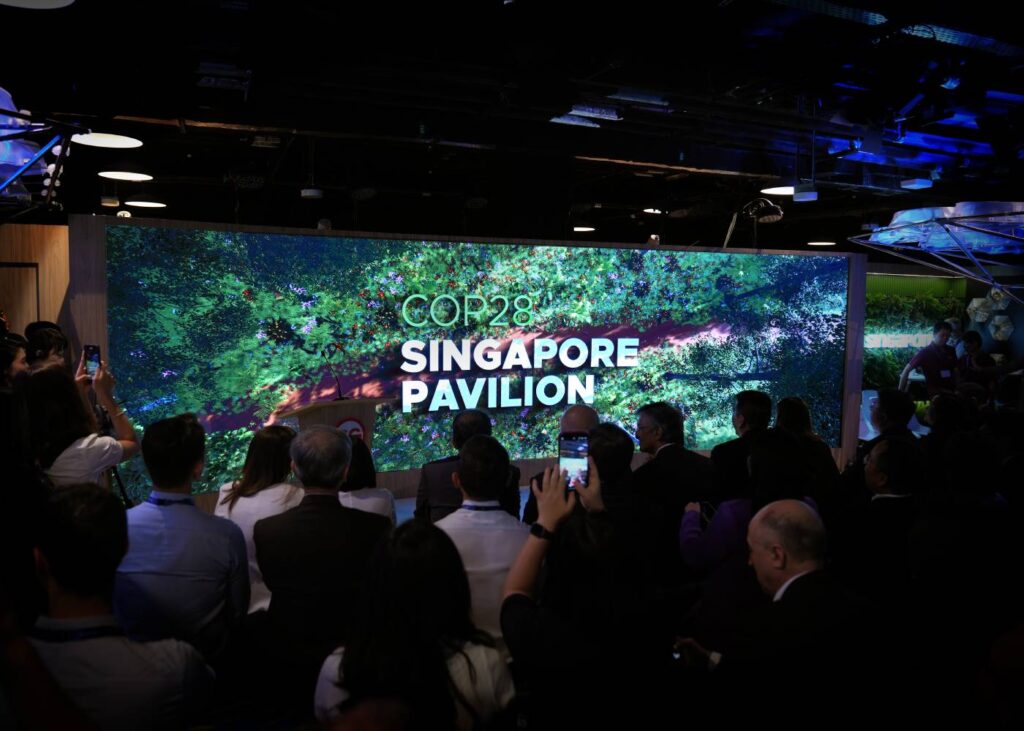
The design of the COP28 Singapore Pavilion and its ‘Waste to Wonder’ theme was inspired by Singapore’s vision of a City in Nature, balancing urban development with environmental sustainability. The Pavilion embodied Singapore’s commitment to innovation, circular design, and climate action, offering a tangible demonstration of how waste can be transformed into purposeful beauty.
The ‘Waste to Wonder’ concept drew from the urgent need to address global waste management challenges while inspiring a shift toward sustainable solutions. By upcycling 3,692 plastic bottles into a striking 3D-printed canopy, the Pavilion symbolized how circular design can turn discarded materials into architectural marvels, reducing waste while enhancing aesthetics.
This theme also reflected Singapore’s collective ethos, showcasing the collaborative efforts of public, private, and people sectors to tackle climate change. The Pavilion’s design was driven by the desire to inspire visitors to see waste as a resource and to catalyze innovative partnerships that align with Singapore’s low-carbon, sustainable future.
2. How did you apply circular design principles in creating the pavilion, particularly in making the centrepiece?

Circular design principles were central to the creation of the COP28 Singapore Pavilion, especially in the design and fabrication of the centrepiece. The approach emphasized reducing waste, reusing materials, and creating a system where resources were repurposed to extend their lifecycle.
Material Upcycling
3,692 plastic bottles were collected, cleaned, and upcycled into raw material for the 3D printing of the centrepiece, demonstrating a closed-loop process where waste became the core resource.
Parametric Design and 3D Printing
- Utilized parametric algorithms to optimize the structure for material efficiency, ensuring minimal waste during fabrication
- 3D printing technology allowed precise use of materials, reducing excess and supporting resource-efficient construction.
Modular and Durable Design
Designed the centrepiece to be modular and easy to disassemble, allowing it to be repurposed or reassembled in future installations, further extending its lifecycle.
Innovative Resource Use
Combined recycled plastics with sustainable materials to create an organic yet functional aesthetic, showcasing the potential of integrating waste into architectural design.
Educational Impact
The centrepiece itself served as a live example of circular design, sparking conversations and educating visitors about the importance and feasibility of adopting circular principles in various industries.
These efforts demonstrated how circular design principles could not only reduce waste but also inspire innovative approaches to construction and design, making sustainability both practical and aspirational.
3. What steps were taken in the design to reduce wastage throughout the project?
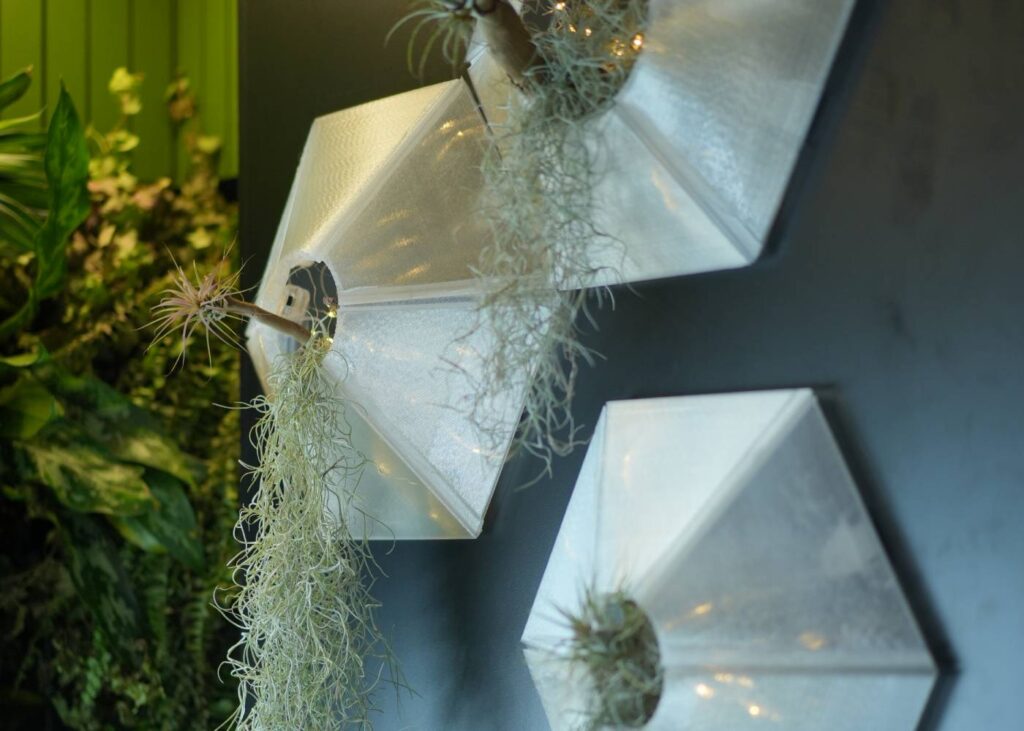
The design of the COP28 Singapore Pavilion incorporated multiple strategies to minimize wastage throughout the project, aligning with sustainability and circular design principles. These steps ensured that resources were used efficiently, materials were reused wherever possible, and waste generation was significantly reduced.
Repurposing Materials
Repurposed paper chairs and acoustic materials from the first iteration of the Pavilion, refreshing them with locally designed cushions to fit the updated aesthetic while minimizing the need for new production.
Digital Solutions
Reduced reliance on print materials, with 90% of branding done digitally and all content shared via multimedia screens and online platforms to cut down on paper waste.
Sustainable Furniture Choices
Used modular furniture and eco-friendly materials, ensuring easy disassembly and potential reuse in future projects.
Efficient Construction Practices
Employed efficient assembly techniques and prefabricated elements, reducing construction offcuts and material wastage.
By integrating these steps, the Pavilion set a benchmark for sustainable design, demonstrating how innovative practices could reduce waste and inspire climate-conscious construction.
4. In what ways did the pavilion facilitate visitor engagement?
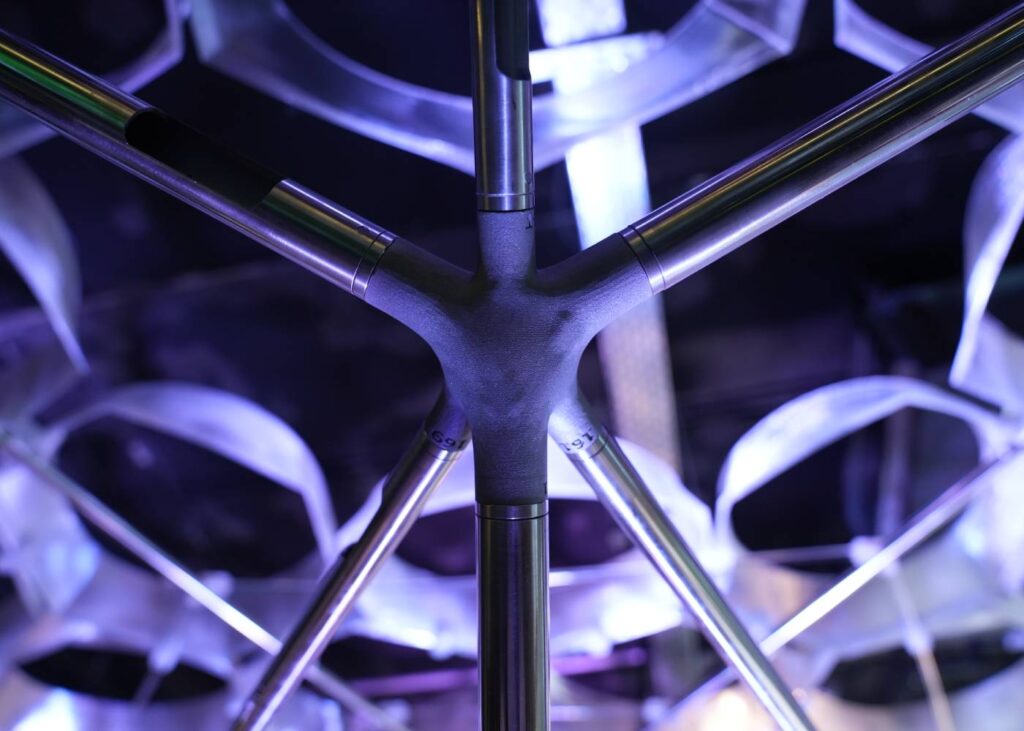
The Singapore Pavilion’s 12-day programme was meticulously curated to cover all COP28 themes, ensuring relevance and engagement for diverse audiences. These programmes were made accessible to a global audience through live streaming, on-demand videos, and all content presented at the Pavilion.
The Pavilion utilized interactive multimedia content to replace traditional print materials, offering visitors bite-sized, accessible information about green initiatives and sustainable innovations. This transformed what could have been a static conference experience into a dynamic, interactive journey that encouraged hands-on exploration of Singapore’s climate action efforts.
The Pavilion also aimed to engage c-suite executives, academics, and youth leaders to advance climate action. In its second phase, it welcomed 158 youth leaders, 280 speakers, and 6,102 visitors who participated in panels and discussions addressing all COP28 themes. Multimedia activations showcased Singapore’s vibrant ecosystem of public and private climate stakeholders, fostering meaningful connections and collaboration.
Throughout the 12 days, the Pavilion created an impactful space that inspired leaders to implement, innovate, and integrate solutions for climate change.
The COP28 Singapore Pavilion fostered visitor engagement through several key strategies:
Interactive Multimedia Displays
- Visitors explored Singapore’s climate initiatives through digital and interactive screens that presented complex information in a visually engaging and accessible format, replacing traditional print materials.
- These displays encouraged hands-on exploration, enabling visitors to delve deeper into Singapore’s ecosystem of public-private climate action partnerships.
Centerpiece as a Conversation Starter
- The 3D-printed canopy, created from upcycled plastic waste, served as a focal point to spark discussions on circular design and sustainability.
- It became a memorable landmark within the Pavilion, drawing visitors and encouraging dialogue around innovative uses of waste materials.
Dynamic Programming
- Visitors engaged with curated programmes tailored to COP28 daily themes, including live-streamed sessions and on-demand videos, making content accessible to both in-person and global audiences.
- This hybrid approach expanded engagement beyond the physical space, enabling wider participation.
Networking Opportunities
- The Pavilion offered thoughtfully crafted spaces for discussions and networking, helping C-suites, youth leaders, and academics connect with like-minded individuals.
- Programs were designed to facilitate collaboration, such as panel discussions and workshops aligned with COP28 themes.
Showcasing Innovations
- Visitors experienced Singapore’s strong ecosystem of climate change actors through real-world examples of sustainable technologies and solutions presented in interactive and engaging formats.
- This created an inspiring environment for idea exchange and learning.
Sustainable, Immersive Environment
By incorporating digital branding, reusable materials, and a “Waste to Wonder” design ethos, the Pavilion itself became a talking point, demonstrating Singapore’s commitment to sustainability in action.
Youth Engagement
The Pavilion hosted youth leaders and interactive sessions to inspire the next generation of climate change advocates, fostering active participation and empowering younger voices.
By integrating interactive elements, a collaborative environment, and impactful storytelling, the Pavilion created an inspiring and engaging experience for all visitors.
5. What lasting impact do you hope the pavilion will have on climate awareness and action?
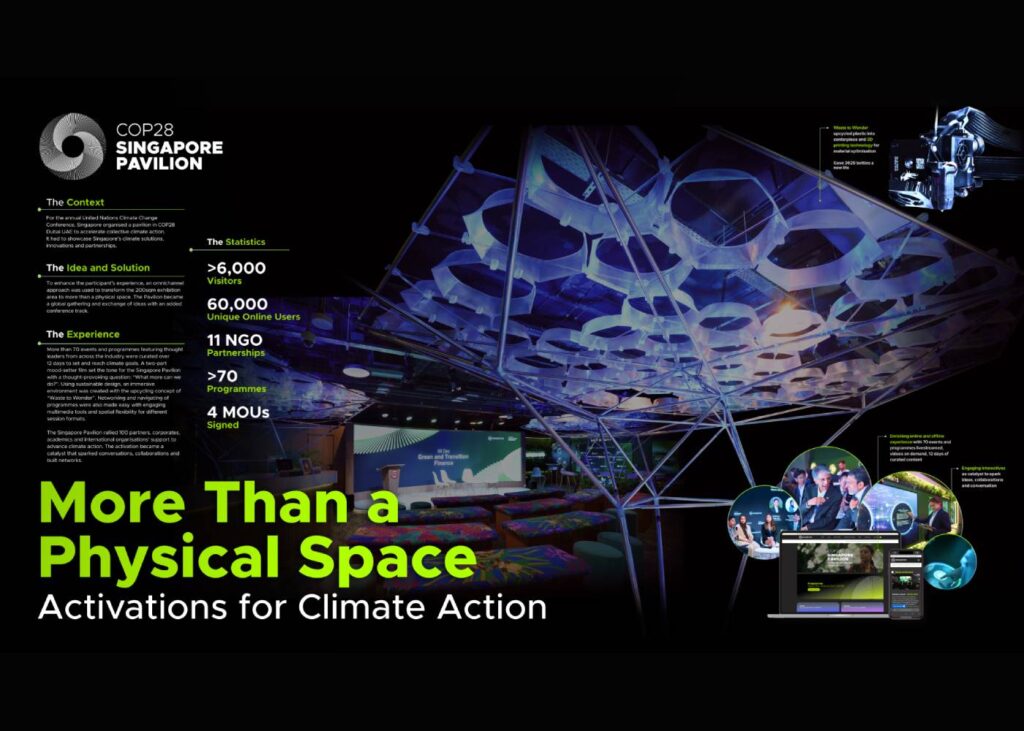
The COP28 Singapore Pavilion was designed not only as a showcase of innovation but as a catalyst for lasting climate awareness and action. Its goal was to inspire, educate, and mobilize individuals and organizations globally to contribute to the fight against climate change. Here are the key areas of anticipated impact:
Inspiring Partnerships
- By gathering over 6,102 thought leaders, 280 speakers, and representatives from various sectors, the Pavilion created a platform where partnerships could form to drive impactful solutions.
- The signing of 9 MOUs during the 12-day event underscored the Pavilion’s role in facilitating long-term commitments and collaborations to address climate challenges.
Shaping Perspectives
- The “Waste to Wonder” theme, embodied in the 3D-printed centerpiece made from upcycled plastic waste, aimed to reshape perspectives on sustainability, demonstrating how waste can be transformed into valuable resources.
- Visitors were encouraged to rethink consumption and adopt circular design principles in their personal and professional lives.
Scalable Solutions
By showcasing Singapore’s strong ecosystem of public-private climate change actors, the Pavilion highlighted real-world solutions and innovations that are scalable and replicable across different contexts.
Empowering the Next Generation
- The Pavilion engaged youth leaders and provided them with tools, platforms, and connections to amplify their voices in climate discussions.
- This focus on youth ensured that the message of collective climate action would resonate with future decision-makers.
Fostering a Cultural Shift
Through its immersive, sustainable design and interactive multimedia experiences, the Pavilion encouraged a cultural shift toward climate-conscious behaviors, emphasizing the integration of sustainability into everyday decision-making.
Extending the Impact Beyond the Event
The hybrid approach, with live streams, on-demand videos, and digital branding, ensured that the Pavilion’s messages reached a global audience, continuing to inspire action long after COP28 concluded.
Vision for the Future
The Pavilion aimed to transcend its role as an event, seeking to spark a global movement rooted in collective action. By combining sustainability with innovation, collaboration, and education, it sought to drive meaningful change. Through impactful storytelling, actionable solutions, and the uniting of diverse stakeholders, the Pavilion established a foundation for lasting influence. Its legacy lies in promoting collaboration, championing sustainable practices, and inspiring future generations to take decisive action against climate change on a global scale.
And that’s a wrap! Huge thanks to Claudia for sharing these incredible insights. Want to dive deeper? Click here to learn more.
If you’re a designer with a standout project ready to make its mark, now’s your chance! Enter the SG Good Design Awards and let your work shine in the spotlight—click the link to find out more!
Wondering what we’re up to next?
Give us a follow and stay in the loop!
About DSGN arcHive
DSGN arcHive is your exclusive key to unveiling the enigmatic essence of a city, all filtered through the prism of design. Far from the ordinary tourist paths. We reveal the city’s architectural marvels, urban intricacies, cultural tapestry, and eco-conscious revolutions that mold its distinctive soul. With us, you’re invited to savor the metropolis in an entirely chic and sophisticated light, a city that’s far more than what meets the eye.
Copyright © 2025 DSGN arcHive


